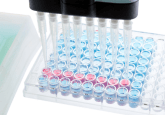Is there a new method for diagnosing cervical cancer on the horizon?

A new method for cervical cancer screening has shown remarkable promise in identifying novel biomarkers with high diagnostic accuracy.
Cervical cancer remains a significant global health concern. As one of the most common cancers in women, there are over 500,000 new cases every year. Even more alarming, the incidence of cervical intraepithelial neoplasia (CIN)—precursor lesions to cervical cancer usually caused by human papillomavirus (HPV) infection— is 20 times higher. Early detection is critical for effective treatment, emphasizing the importance of innovative and accessible screening methods.
Traditional screening methods, including HPV tests and cytology examinations, have limitations. Although cytology is a common screening method worldwide, its sensitivity in detecting CIN is low. Conversely, HPV tests possess the sensitivity cytology tests lack, but have poor specificity. These shortfalls have exposed a need for improved diagnostic approaches, driving researchers to explore new avenues.
Setting out to address this diagnostic gap, a team led by Professor Takuma Fujii at Fujita Health University (Toyoake, Japan) has made significant strides in this area. Their recent study, published in Cancer Science, identified a series of abnormally expressed microRNAs (miRNAs) and cytokines in the serum and cervical mucus of cervical cancer and CIN patients at Fujita Health University Hospital (Toyoake, Japan).
You may also be interested in:
- T-cell receptors could be the answer to detecting high-grade ovarian cancer early
- AI-supported biomarker panel identifies early-stage cancers with >99% accuracy
- How Treg cells impact CAR-T therapy: insights from the Cancer Correlative Science Unit
By comparing miRNA and cytokine profiles in the serum and cervical mucus from these patients, then analyzing them using miRNA real-time PCR tests and cytokine immunoassays on a larger sample size, the team identified and validated the abnormal expression of specific biomarkers.
They then assessed the diagnostic potential of these biomarkers and discovered that although serum miRNAs and cytokines lacked diagnostic potential, a specific combination of miRNAs and cytokines in mucus samples displayed high diagnostic accuracy.
This novel approach suggests that the analysis of local expression levels of these biomarkers, rather than serum expression levels, might be a superior method for early detection.
Fujii highlighted the significance of these findings: “Our study, for the first time, demonstrates that analyzing mucus samples can distinguish cervical tumors from normal tissues more accurately than serum samples. Using such a method as an additional option to traditional screening techniques could help discover cancer and precancerous conditions at an earlier stage.”
While additional research on larger populations is required to validate these results, this novel method shows promising potential to create less invasive screening procedures, reducing the need for colposcopies and decreasing healthcare costs.






